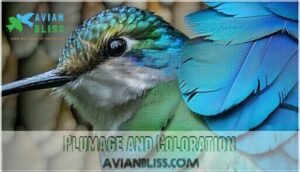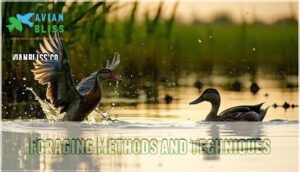This site is supported by our readers. We may earn a commission, at no cost to you, if you purchase through links.

These social waterfowl thrive in freshwater marshes, rice fields, and shallow wetlands across four continents, making them one of the world’s most widely distributed duck species.
Unlike typical ducks, they prefer warm tropical and subtropical regions where they dabble for aquatic plants, seeds, and rice.
Their characteristic whistling calls echo across wetlands as they gather in large flocks outside breeding season.
Both parents share incubation duties for their cream-colored eggs, maintaining strong family bonds throughout the fledgling stage.
Their unique adaptations reveal fascinating survival strategies.
Table Of Contents
- Key Takeaways
- Fulvous Whistling Duck Habitat
- Physical Characteristics
- Diet and Foraging
- Breeding and Nesting
- Behavior and Conservation
- Frequently Asked Questions (FAQs)
- How rare is a fulvous whistling duck?
- Are fulvous whistling ducks good to eat?
- Where do fulvous whistling ducks live?
- What is the difference between Fulvous and black-bellied whistling duck?
- What is the difference between black-bellied and fulvous whistling duck?
- Do Fulvous Whistling-Ducks migrate?
- What is the status of fulvous whistling duck?
- What are the vocal communication methods of this duck?
- Are fulvous whistling-ducks diurnal or nocturnal?
- How do they care for their offspring?
- Conclusion
Key Takeaways
- You’ll spot them by their distinctive tawny-brown plumage and blue-gray bill – these medium-sized ducks have rich caramel coloring that makes them easy to identify in freshwater marshes and rice fields
- They’re incredibly social and adaptable foragers – you’ll find them in large flocks using multiple feeding techniques like dabbling, diving, and walking through shallow fields to access aquatic plants and rice
- Both parents share equal responsibility in raising young – they alternate incubation duties for 24-26 days and cooperatively guide their precocial ducklings until they fledge at 7-9 weeks
- They’re one of the world’s most widely distributed waterfowl – you can find these resilient birds across tropical and subtropical regions in the Americas, Africa, and Asia, though they face conservation challenges from habitat loss and pesticide use
Fulvous Whistling Duck Habitat
You’ll find fulvous whistling ducks in warm freshwater marshes, rice fields, and shallow wetlands across tropical regions of the Americas, Africa, and Asia.
These adaptable birds prefer areas with emergent vegetation and ideal water depths for their dabbling and diving feeding habits.
Freshwater Marshes and Rice Fields
You’ll find fulvous whistling ducks thriving in freshwater marshes and rice fields across warm regions worldwide.
These adaptable waterfowl make rice fields and marshes their perfect home across tropical regions worldwide.
These wetland birds prefer specific water depths for ideal foraging, making them perfectly adapted to marsh ecology.
Here’s what attracts them:
- Rice agriculture areas – flooded fields provide abundant seeds
- Shallow marshes – ideal water depth for dabbling and diving
- Emergent vegetation zones – offer protection and nesting sites
Regional variations in duck habitat quality directly impact population distribution, while habitat loss threatens these specialized environments.
Breeding and Wintering
You’ll find Fulvous Whistling Ducks year-round in central Florida’s wetlands, while Texas and Louisiana populations migrate seasonally.
Their nesting ecology varies by region, with breeding success tied to water levels and wetland birds’ community dynamics.
These winter habitats support massive flocks. Like the closely related Black-bellied Whistling Duck, they also utilize nest boxes for breeding.
| Season | Location | Behavior | Habitat Use |
|---|---|---|---|
| Breeding | Gulf Coast, Florida | Nesting, territorial | Dense marsh vegetation |
| Winter | Same regions + Mexico | Flocking, foraging | Rice fields, open water |
| Migration | Texas, Louisiana | Seasonal movement | Stopover wetlands |
| Year-round | Central Florida | Resident populations | Permanent marshes |
Geographic Distribution
You’ll find Fulvous Whistling Ducks across three continents, making them one of the world’s most widely distributed waterfowl species.
Their Global Habitats span tropical and subtropical regions where rice cultivation and wetlands intersect perfectly.
The species shows remarkable Regional Variations in distribution patterns:
- Americas: From southern United States through Central America to northern Argentina
- Africa: Sub-Saharan regions including the Nile Valley and West African wetlands
- Asia: Indian subcontinent through Southeast Asia, following monsoon patterns
Migration Patterns remain largely local, with birds responding to seasonal water availability rather than true long-distance movements.
Introduced Populations have established successfully in parts of the Caribbean and southern United States, while Habitat Loss threatens regional populations despite the species’ overall stable Distribution status.
Physical Characteristics
You’ll easily recognize the Fulvous Whistling Duck by its distinctive tawny-cinnamon coloration and unique proportions that set it apart from other waterfowl.
This medium-sized duck displays rich caramel-brown plumage with a darker back, long gray legs, and a blue-gray bill that makes identification straightforward in the field.
Plumage and Coloration
You’ll notice the Fulvous Whistling Duck’s stunning caramel-brown plumage immediately.
This butterscotch color dominates their body, creating their distinctive tawny appearance.
Adults sport darker backs with subtle scalloping, while their flanks display white stripes.
The white rump patch becomes visible during flight.
Juvenile plumage appears duller and paler than adults, lacking the rich butterscotch tones.
Seasonal changes remain minimal in this species.
Bill and Leg Color
You’ll recognize Fulvous Whistling Ducks by their distinctive blue-gray bill and matching gray feet.
This bill pigmentation sets them apart from Black-bellied Whistling-Ducks, whose bills appear pink. The gray bill’s appearance remains consistent year-round, unlike some waterfowl where color development varies seasonally.
These genetic factors in leg variation and bill coloration serve a camouflage role, helping the birds blend with marsh vegetation while foraging.
When identifying birds, remember that plumage showcases unique patterns to help differentiate species, using physical characteristics and distinctive features.
Size and Weight
You’ll find these ducks are medium-sized waterfowl with average mass ranging from 1.2-2.1 pounds.
Wing length spans 8.2-8.4 inches, showing minimal sexual dimorphism between males and females.
Adults measure 45-53cm in length with an 85-93cm wingspan.
Juvenile size appears duller and smaller than adults, particularly in body proportions and overall appearance, making bird species morphology identification easier.
Diet and Foraging
You’ll find that fulvous whistling ducks aren’t picky eaters, with over 95% of their diet consisting of plant material like seeds from aquatic plants and rice.
These adaptable birds use various foraging techniques including dabbling, swimming, diving up to three feet deep, and even walking through damp fields to find their preferred foods, utilizing different techniques.
Food Sources and Preferences
After noticing the duck’s striking colors, you’ll spot them in rice fields and marshes, heads down, searching for seeds and aquatic plants.
Their diet leans heavily toward seed consumption, with rice consumption topping the menu when available.
During breeding, females up their insect consumption, adding invertebrates for extra protein.
Fulvous Whistling Ducks exhibit ground feeding behaviors, often scratching for food.
The fulvous whistling duck’s seasonal diet shifts as food sources change, and they display ground feeding behaviors in various environments.
Foraging Methods and Techniques
You’ll spot Fulvous Whistling Ducks using varied foraging methods to access their preferred aquatic plants and rice.
They employ upending strategy like dabbling ducks, tipping forward to reach submerged vegetation.
These adaptable birds also walk through shallow rice fields, swim across open water, and occasionally dive to depths of one meter.
Their seasonal diet changes drive different nocturnal foraging techniques throughout the year.
Social Foraging Behavior
Fulvous Whistling Ducks excel at social foraging, with mixed flocks often exceeding 200 birds working together like a well-oiled machine.
These social birds boost their foraging success through cooperative hunting and competition avoidance strategies.
Group size directly impacts bird behavior – larger flocks mean better predator detection and resource sharing. When you observe their flocking patterns, you’ll notice enhanced efficiency compared to solitary foraging attempts, which is a result of their cooperative hunting.
Breeding and Nesting
When you study fulvous whistling ducks during breeding season, you’ll discover they’re remarkably flexible nesters who build their homes both on the ground near water and occasionally in trees.
These devoted parents work together through every stage, from selecting the perfect nesting site to raising their young until they’re ready to fly on their own, making them very devoted parents.
Nesting Sites and Materials
You’ll find these birds building their nest site on the ground near water or in dense marsh vegetation.
They prefer areas with thick grass coverage that provides natural camouflage and protection. Unlike many waterfowl, they rarely choose elevated locations like trees, except occasionally in India.
The nest itself is a simple structure made from surrounding marsh grass and vegetation. Consider purchasing suitable nesting materials to support healthy nesting.
Egg Laying and Incubation
How many eggs can you expect from these remarkable ducks? Fulvous Whistling Ducks typically lay 12-14 white eggs per clutch, though clutch size ranges from 6-16.
The incubation period lasts 24-26 days, with both parents sharing parental roles equally.
Dump nesting behavior creates "super clutches" containing 60+ eggs when multiple females use the same nest site, making some nests quite crowded, which is a result of remarkable behavior and can lead to crowded conditions.
Parental Care and Fledging
Both parents share incubation duties equally, alternating throughout the 24-26 day incubation period.
After hatching, cooperative breeding emerges as adults jointly guard their precocial young.
Ducklings leave the nesting area within hours, guided to favorable feeding sites.
Chick development accelerates under constant parental investment and vigilance.
Fledging occurs around seven to nine weeks, though post-fledging survival depends heavily on habitat quality and predator presence.
Behavior and Conservation
You’ll discover that fulvous whistling ducks are surprisingly social creatures, often forming large flocks that can include hundreds of birds during migration and wintering periods.
Understanding their behavior patterns and conservation challenges helps explain why these distinctive waterfowl continue to thrive across multiple continents despite facing various environmental pressures, which is a key aspect of their conservation.
Social Behavior and Flocking
These highly social birds demonstrate remarkable group dynamics that enhance their survival and foraging success.
You’ll observe flocking benefits as they gather in large numbers, creating safety through collective vigilance.
Mixed flocks with Black-bellied Whistling-Ducks showcase their adaptable social hierarchy and cooperative bird behavior patterns.
- Hundreds of birds creating thunderous wingbeats during evening flights to nocturnal roosting sites
- Sentries standing alert while others feed, rotating guard duty like a well-organized neighborhood watch
- Young ducklings swimming in tight formations, following experienced adults through marsh channels
- Groups splitting and merging fluidly as they navigate between feeding areas and resting spots
Communication and Calls
You’ll instantly recognize fulvous whistling ducks by their distinctive duck call repertoire. These vocal birds produce high-pitched calls and hoarse whistle sounds that carry across marshlands.
Their vocalizations include alarm calls when threatened, soft chick communication between parents and young, and melodic whistling duets between mates.
Different vocalization types serve specific purposes, with call frequency increasing during breeding season when their songs echo through wetlands.
These calls are a form of vocal communication essential for survival.
Threats and Conservation Status
Despite their wide distribution, fulvous whistling ducks face mounting conservation concerns that threaten their long-term survival.
These resilient birds confront challenges that span continents, affecting their population status across multiple regions.
Current threats include:
- Habitat Loss – Wetland drainage reduces breeding grounds by 30% in some areas
- Pesticide Use – Chemical contamination causes up to 17% egg mortality rates
- Hunting Pressure – Illegal harvesting decreases populations by 15% regionally
- Climate Change – Altered rainfall patterns destroy nesting sites during droughts
- Conservation Efforts – Protected areas cover less than 20% of breeding range
While classified as Least Concern globally, regional declines occur where wetlands face heavy depletion.
Supporting duck nesting structures can improve breeding success.
Conservation initiatives focus on sustainable farming practices and international wetland protection agreements.
Frequently Asked Questions (FAQs)
How rare is a fulvous whistling duck?
Like finding a needle in a haystack, you’ll discover these ducks aren’t particularly rare globally.
They’re found across 70+ countries spanning Americas, Africa, and Asia, though they’re uncommon in most U.S. locations outside Texas, Louisiana, and Florida.
Are fulvous whistling ducks good to eat?
You can eat fulvous whistling ducks, and they’re considered tasty by hunters.
They’re legal game birds with designated hunting seasons in states like Texas and Louisiana, offering mild, flavorful meat similar to other waterfowl, which is considered mild.
Where do fulvous whistling ducks live?
You’ll find these birds across warm regions in the Americas, Africa, and Asia. They prefer freshwater marshes, rice fields, and flooded pastures, especially in Texas, Louisiana, and Florida.
What is the difference between Fulvous and black-bellied whistling duck?
Like spotting twins at opposite ends of a family photo, you’ll notice the fulvous has a gray bill and tawny coloring.
While black-bellied sports a bright pink bill and distinctive black belly patch.
What is the difference between black-bellied and fulvous whistling duck?
You’ll spot the difference immediately: black-bellied whistling ducks have bright pink bills and dark bellies, while fulvous whistling ducks sport gray bills and tawny-cinnamon coloring throughout their bodies.
Do Fulvous Whistling-Ducks migrate?
Fulvous Whistling-Ducks don’t follow traditional migration patterns. They’re more nomadic, moving seasonally between wetlands based on water levels and food availability rather than fixed routes.
What is the status of fulvous whistling duck?
Currently, IUCN estimates 3 to 5 million individuals globally, with populations increasing in the U.S. but declining elsewhere.
Numbers are rising domestically while facing challenges abroad from habitat loss and hunting pressure.
What are the vocal communication methods of this duck?
You’ll hear these waterfowl produce distinctive whistling calls that give them their name.
Their vocalizations include soft whistles, chattering sounds, and melodic notes used for communication between mates, flock coordination, and territorial displays during breeding season.
Are fulvous whistling-ducks diurnal or nocturnal?
You’ll find these ducks are neither strictly diurnal nor nocturnal—they’re active both day and night. They forage around the clock, often joining mixed-species flocks during their feeding sessions.
How do they care for their offspring?
Picture a Louisiana rice field where parent ducks guide their fluffy ducklings through shallow water.
You’ll see both parents alternating incubation duties for twenty-four days, then tending their independent young who find their own food but stay close for protection until fledging.
Conclusion
Understanding the fulvous whistling duck reveals nature’s remarkable adaptability in action.
You’ve discovered how these resilient waterfowl navigate diverse wetland habitats across continents, forming strong social bonds while maintaining their distinctive behaviors.
Their success stems from flexible foraging strategies, cooperative breeding patterns, and effective communication systems.
Whether you’re observing them in rice fields or freshwater marshes, you’ll appreciate how the fulvous whistling duck exemplifies successful species adaptation in our changing world.
- https://www.tn.gov/twra/wildlife/birds/waterbirds/fulvous-whistling-duck.html
- https://www.allaboutbirds.org/guide/Fulvous_Whistling-Duck/overview
- https://www.waterfowl.org.uk/wildfowl/whistling-ducks/fulvous-whistling-duck/
- https://www.yucatanbirds.org/non-passerines-group-i/anatidae/fulvous-whistling-duck
- https://www.marylandzoo.org/animal/fulvous-whistling-duck/











